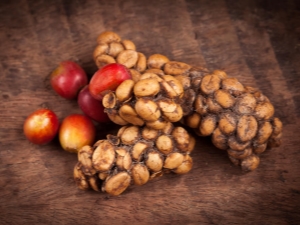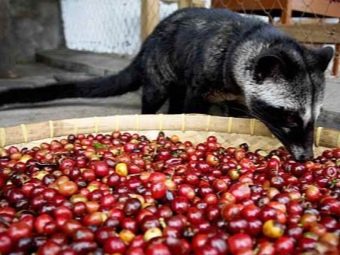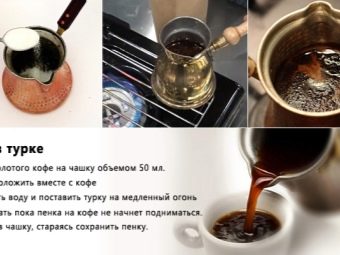Characteristics of the most expensive coffee in the world - kopi luvak

Probably, no one will argue with the fact that coffee is one of the most beloved and popular drinks among residents of different countries of the world. Varieties and methods of its preparation today there are a huge amount. Our article is devoted to an unusual, very rare and exotic kind of beloved coffee.
This drink is honored and loved by a very limited circle of connoisseurs. Its peculiarity lies in the unique and unique processing of grains. This is the best gourmet coffee - save lyuvak. Since the mid-twentieth century, this drink has become very popular in the East, and in the early nineties of the twentieth century it was duly appreciated in the USA and Europe.
Origin
In the XIX century, the Dutch categorically forbade plantation workers in Indonesia to use a drink brewed from coffee beans. Locals accustomed to the traditional use of the drink, found an opportunity to circumvent this ban. They drew attention to the fact that animal excrement contained uncooked grains, decided to wash them well and make a drink. It turned out to be much tastier than the usual brewed coffee. This is how a drink appeared that was fermented by representatives of the animal world, eating soft berries of coffee tree.
This representative of the fauna is a small animal with sad eyes, very similar to affection, marten and a bit similar to our domestic cat. It belongs to the civet family and is called musang or palm civet. This small and nimble animal in the age of an adult animal has a body 50 cm long and has almost the same tail length. It is very active and moves quickly both among the branches of trees and on the ground. The animal has a weight of not more than 15 kg. These animals are hunters target. They are interested not only in valuable civet fur, but also very tasty delicious meat.
The habitat of the furry animal is the tropics and evergreen forests of India, southern China, mainland Indochina, the islands of Indonesia, the southern part of the Philippines and Vietnam. Musang is omnivorous. He is, above all, a predator and uses small rodents, birds, members of the amphibian family, does not refuse from insects.
Eats wild fruits and prefers coffee tree berries. The scent of the animal is much thinner than a human. Due to his receptors, he chooses the highest quality fruits of Robusta or Arabica. Coffee fruit loves for their sweetish taste.
Where are the coffee plantations?
Lyuvak is actively involved in the production of mines in Indonesia and Vietnam.
Indonesia Plantations
The islands of Java, Sumatra and Sulawesi are famous for their coffee plantations. The Dutch started to grow coffee in Indonesia in the 17th century. In Europe, the first batch of Indonesian coffee was sold in Amsterdam in 1712.
In the 80s of the XIX century, coffee trees were massively affected by rust fungus, production stopped completely. It was revived only in the 50s of the twentieth century, after the country gained independence. Locals began to grow Arabica, which was brought to the country from India by the Dutch. A little later, Indonesians from Africa brought Robusta.
In Bali, most of the coffee plantations are located in the Kintamani province. It will not be possible to purchase coffee beans here, as farmers have contracts with local coffee shops and wholesale companies exporting products.
The rest of the small plantations in Bali exist as entertainment places for tourists. At the famous resorts of Bali for the exotic sent a huge number of tourists from around the world. Drink here is considered very expensive.
The price was formed not because of the quality of the product, but because of the high demand from tourists. A tourist will not distinguish a fake from a true coffee, it can be noticed only by a real gourmet. Unfortunately, fakes are famous not only for Bali, but for Fr. Java, Sumatra and Vietnam.
Vietnam plantations
In the provinces of Vietnam, coffee is produced in Chon, an analogue of the mine lyuvak.Coffee production appeared in Vietnam during the French colonization, with the arrival of which the first coffee plantations were created in the country. Vietnam entered the international market with its products in the middle of the 20th century. The volume of deliveries was fixed by this time at the level of second place in the world.
The second Indochina war with the Americans led to a sharp drop in coffee production in Vietnam. In the difficult times of military operations in the period from 1964 to 1975, the amount of Vietnamese coffee in the world market sharply decreased. The rise of production began only in the eighties of the twentieth century. By 1996, the country regained an honorable second place in the international market, and in 2012 it outstripped Brazil and ranked first. 90% of the plantations are in the hands of private producers, the state’s share is the remaining 10%.
The first plantations after the war were planted in the 80s in the highlands of Dalat in the province of Lamdong. Here is the perfect climate for growing coffee. By the beginning of 2000, the Thai Nguyen plateau was planted in the center of Vietnam. At the moment, the area of coffee plantations stretch over 503 thousand square kilometers. Chon (Vietnamese mines lyuvak) produced on numerous farms in the province of Dak Lak.
Production technology
The secret to making a coffee is that luvak is located inside the body, in the intestine of the musang. Gastric palm civet juice is able to break down the proteins, carbohydrates and fats found in coffee fruits, giving the future drink special notes of bitterness. Fruits passing through the entire digestive system of the animal are not damaged at all and remain intact.
In the process of fermentation, inside the animal, the upper shell of the fruit is digested, which gives the flavor and aroma of the future drink, prepared from grains extracted from the animal feces. The peculiarity of the body musang is that the enzyme that affects the coffee fruits is produced in it no more than six months a year.
The process of fermentation inside the animal in the 80s of the twentieth century was studied in detail by scientists from Canada. According to the results of the study, they concluded that bacteria and microorganisms that are in the intestine of the musang, in the process of fermentation completely change the grain structure and significantly change its properties.
In the process of digestion, the upper flesh on the surface of the fetus is beneficial to the animal. The remaining structure of the coffee fruit is not damaged at all and naturally leaves the animal. In this way it turns out almost finished product.
The work process of local farmers consists of several tasks: to collect animal excrement, dry in the sun, then rinse the grain well in running water. The resulting washed product is laid out in the sun to dry. Then the roasting process is performed To keep the taste of the drink delicate, the coffee beans are roasted for a short time.
To obtain high-quality coffee, animals must be exclusively in their natural habitat or close to it. Musangs cannot breed in captivity. Next to the plantations, they specifically enclose areas where it is convenient for people to serve animals. Farmers have to manually collect the best and ripe fruits of the coffee tree for the animals.
Musangs are nocturnal animals. At night, they become very active, so they need to be fed from late evening until early morning. Farmers assure that if they do not control the amount of food eaten, then animals can swallow a very large amount of fruit and will feel unwell.
Only three times a week, musangs are given coffee berries. A portion for a day is not more than 200 g per musang. In the remaining days of the week, soups are prepared from animals from chicken meat, rice, noodles, and also bananas and corn are given.
The animals are very capricious and picky in their food, so farmers have to be very selective in their diet.In addition, experienced veterinarians, leading personal medical records, are assigned to the musangs. They are obliged to monitor the health of the Musangs.
How to brew?
Gourmets for the mine luvak are ready to lay out a lot of money in order to enjoy a cup of such exotic coffee. The drink has a peculiar taste, quite unlike the traditional coffee. Appreciate it properly can only real gourmets - lovers of this particular coffee. It has an original flavor, rich, extremely dense and soft. According to lovers of this drink, it has a harmonious balanced taste with a delicate bitterness and the presence of shades of nougat and honey, notes of delicate chocolate and a steady nutty aftertaste.
Experts and gourmets say that the preparation of the mine lyuvak is carried out on the same principle as traditional coffee. The drink is brewed in a Turk, a traditional drip coffee maker and in a french press. In the United States and Europe, the process of cooking in Turku is called "Oriental."
In Indonesia, tourists are offered a drink in small straw buildings - coffee houses, called Mines Warm. In such cafes for many visitors and locals make coffee, prepared in the best ancient traditions. In the small hut of straw there is only a stand where the preparation of the drink takes place, and a long bench on which to sit down to enjoy it.
Prepare coffee immediately when ordering - in front of the buyer. The drink offers a variety of pastries with a variety of exotic flavors of Indonesian fruit. The owner of the coffee house offers various recipes: classic, Indonesian with various spices, but most often guests order coffee with condensed milk, which softens the taste of the drink.
In the traditions of Indonesia to make coffee with the addition of brewed cocoa. Brewed strong ground coffee in Turkish. Cocoa is brewed in the same amount of water. Both drinks are mixed, brought to a boil, but not boiled. Prepared drink drink with added sugar and grated almonds.
Vietnamese brewed drink in accordance with their traditions, which came from the depths of centuries. Use metal cups, which are embedded in a sieve and press. Pour boiling water over them, cover with a lid, cover with a thick cloth. The drink is infused and seeps through a sieve in small portions.
Vietnamese prefer to drink it with sugar. A sweet drink is very tart, without sugar it is softer and more tender. In Europe, there is a tradition to use the luvak mine with the addition of a few ice cubes. In the East, on hot days, the lyuvak mines drink in combination with green tea.
Interesting Facts
Many different stories are told about the origin and production of expensive coffee. The animal protection community is convinced that all animals live in captivity, in dirty, cramped cages without freedom of movement. In their view, very expensive miracle coffee "from the wild region" goes to humanity due to the serious suffering of animals. Locals rightly refute this fact, convincing everyone that the majority of animals live and reproduce in natural conditions.
Of the entire animal world, only two of its representatives ferment the coffee fruits inside their digestive tract - musang and elephant.
Visiting the countries of Southeast Asia on tourist trips, travelers consider only Vietnamese drink to be relatively cheap, which is sold in almost all cafes and shops that are accessible to tourists.
Chon (Vietnamese lyuvak) - the best gift for their loved ones and friends, brought from a trip to Vietnam.
Why is it so expensive?
Many believe that coffee has such a high cost due to the fact that local farmers have to look for and collect animal waste. Agree, this work can not be enjoyable. The reason, however, lies elsewhere.The cost of the mine is due to the numerous expenses of farmers to care for plantations, maintenance of wild animals that require special care, the payment of wages to employees and other nuances.
It should be noted that during the fermentation of one kilogram of coffee beans, the output is only about 50 g. This is the main reason for the high price of the product: the output of the grains remains much less than with the traditional production of coffee granules.
The cost of products is largely influenced by advertising.
- Oprah Winfrey, having dropped only one random phrase in a famous American television show in 2007, had the effect that the cost of one cup of coffee in New York was inflated to $ 100, and in London in one instant reached 145 pounds.
- Jack Nicholson, who played the millionaire-lover of this exotic drink in the American film “Until he played in the box,” greatly influenced the world rating of the mine lyuvak.
- In Indonesia, the cops luwak, when purchased on plantations, is estimated by farmers at $ 15 per 100 g. Wholesale purchase will cost $ 100 per kilogram. In Europe, wholesale manufacturers set a price for a product equivalent to $ 400 per kilogram. In the European retail trade per pack of coffee will be asked for $ 100 per 100 g. In Vietnam, for certain varieties, the price per kilogram can reach $ 6,600.
- For two decades, miner lyuvak wore the title of one of the most expensive drinks in the world. In 2012, the palm moved to a brand new drink Black Ivory, which appeared in Thailand and the Maldives.
- In Russia, save lyuvak in ordinary stores is very difficult to find. It is best to buy it under the order on the Internet.
In the next video you will find the informative report of the NTV channel on coffee Kopi luvak.




































